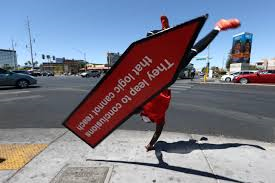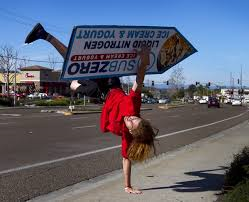Examples of Offline Sign Spinners:





Sign spinning, also known as human directionals or sign twirling, has become a popular method of marketing, especially for small businesses and companies looking to grab immediate attention. It’s not just about holding a sign; it’s an eye-catching, entertaining, and interactive way to advertise. In this article, we will explore the origins, purpose, techniques, and business advantages of sign spinning, providing a deep dive into this intriguing form of advertising.
What is Sign Spinning?
Sign spinning refers to the practice of hiring individuals, often stationed on busy street corners or near retail outlets, to hold and spin signs advertising a business, event, or special promotion. These individuals, known as sign spinners, aren’t simply standing there holding a sign; they engage in a blend of dance, acrobatics, and tricks to create an engaging and often theatrical display. Their job is to draw the attention of passersby, whether they are driving, walking, or biking.
The signs themselves are usually large, with bold graphics and bright colors, designed to communicate the business’s core message in seconds. These signs are typically arrow-shaped, pointing potential customers toward the advertised location.
History of Sign Spinning
Sign spinning as a business model emerged in the early 2000s, pioneered by companies like AArrow Sign Spinners, which has since turned it into a global business. However, the roots of using people to hold signs date back centuries. For instance, sandwich boards worn by individuals in busy markets were a common sight in the 19th and early 20th centuries. As digital marketing grew, businesses began to seek ways to break through the noise and return to more tactile, engaging forms of marketing, which led to the evolution of sign spinning into its modern form.
The Skill of a Sign Spinner
Sign spinning may look like fun, but it requires skill and practice to be effective. Spinners are often trained to perform a range of tricks that include flips, tosses, and complex spins. Some sign spinners even incorporate elements of breakdancing or gymnastics into their routine. These performances aren’t random—they’re carefully choreographed to hold the viewer’s attention and communicate a message in a short span of time.
Here are a few basic tricks sign spinners commonly use:
- The Helicopter: A basic move where the sign is spun horizontally like a helicopter blade.
- The Juggler: The sign is tossed up into the air and caught with a smooth motion, creating an illusion of juggling.
- The Hand Switch: Spinners rotate the sign between both hands rapidly, adding flair to the display.
- The Flip: The sign is tossed into the air with a flip and caught in the same or opposite hand.
- The Spin and Point: A dynamic combination where the spinner twirls the sign and then abruptly points it toward the intended direction (often used to guide traffic toward a store or event).
These tricks not only create visual interest but also help the spinner maintain high energy and engage with their audience. Experienced sign spinners are often highly sought after for their ability to capture attention in the midst of busy environments.
Why Sign Spinning Works: Psychological and Marketing Benefits
- Grabs Immediate Attention: Human beings are wired to notice movement. A stationary sign is often overlooked, but a spinning, flipping, or dancing sign draws attention quickly. This is particularly effective in busy urban areas where businesses are competing for the limited attention span of drivers and pedestrians.
- Creates an Emotional Connection: Sign spinning is often theatrical and entertaining. The combination of acrobatics, bright signs, and upbeat music can create a fun, feel-good environment. This emotional connection, even if brief, helps businesses build brand recognition.
- Personal Interaction: Unlike traditional billboards or digital ads, sign spinners provide an element of human interaction. They wave at passersby, smile, and occasionally even perform to the rhythm of nearby music. This personal touch makes the advertisement feel more genuine and approachable.
- Improves Brand Visibility: Sign spinners often perform in high-traffic areas, such as intersections or popular shopping districts. The combination of their movement and a brightly colored, well-designed sign ensures that people will notice the business being advertised. Since most people make decisions on-the-go, sign spinners help direct them to a store or event at the perfect moment.
- Cost-Effective Marketing: Compared to other forms of advertising, like billboards or online ads, hiring a sign spinner can be relatively inexpensive. A well-placed, skilled spinner can drive significant foot traffic to a business for a fraction of the cost of more traditional advertising methods.
- Versatile and Immediate: Sign spinners are versatile—they can advertise new store openings, special promotions, sales, or events. Unlike printed ads, which require lead time and design approval, sign spinning offers real-time marketing flexibility. A business can easily change its messaging based on day-to-day promotions or customer traffic patterns.
Sign Spinning Competitions and Professionalization
As the craft of sign spinning has grown, so too has its professional aspect. Today, sign spinning has become a competitive sport of sorts, with international competitions drawing sign spinners from all over the world. These competitions feature categories like “Best Trick,” “Most Creative Routine,” and “Most Effective Spinning.”
One such event is the World Sign Spinning Championships, held annually in Las Vegas, where top spinners compete for recognition and prizes. Contestants are judged not just on their tricks but also on their ability to communicate a message effectively through their performance. The rise of these competitions has elevated the art of sign spinning, encouraging spinners to perfect their craft and innovate new tricks.
Business Impact of Sign Spinning
Small businesses, large corporations, and event planners have all benefited from sign spinning as a marketing strategy. Businesses like fast-food chains, tax preparation services, and furniture stores frequently use sign spinners to promote special deals or grand openings.
According to studies, businesses that employ sign spinners can see as much as a 30% increase in foot traffic, particularly when combined with other local advertising strategies. Many companies have adopted this marketing tactic during economic downturns or competitive seasons when drawing customers in-store is crucial.
The Future of Sign Spinning
As digital advertising continues to saturate the market, traditional advertising methods like sign spinning provide a refreshing alternative. With sign spinners becoming more professional and skilled, the industry will likely continue growing. Some companies are also experimenting with combining sign spinning with social media campaigns, recording spinners’ routines and posting them online for additional exposure.
In addition, eco-friendly innovations like using LED-lit or digital signs are becoming more common, allowing sign spinners to work effectively in the evenings or during overcast weather, thereby maximizing the potential audience reach.
Conclusion
Sign spinning is a unique blend of physical performance and marketing, offering businesses an engaging and cost-effective way to capture attention in a busy world. What started as a simple way to point people toward stores has evolved into an art form, with professional spinners and global competitions showcasing just how effective this method can be.
For businesses looking to stand out from the crowd, sign spinning offers an innovative, human touch that makes an immediate impact. Whether it’s a flashy flip of a sign or a well-executed spin at a busy intersection, this marketing strategy has proven its worth in today’s fast-paced, attention-driven world.
